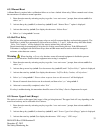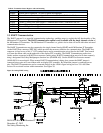
43
MAN-0076 Rev 05 Millennium II
December 07, 2012
Net Safety Monitoring Inc
Appendix
Appendix A: ELECTROSTATIC SENSITIVE DEVICE (ESD)
Definition: Electrostatic discharge (ESD) is the transfer, between bodies, of an electrostatic charge caused by direct
contact or induced by an electrostatic field.
The most common cause of ESD is physical contact. Touching an object can cause a discharge of electrostatic
energy—ESD! If the charge is sufficient and occurs near electronic components, it can damage or destroy those
components.
In some cases, damage is instantaneous and an immediate malfunction occurs. However, symptoms are not always
immediate—performance may be marginal or seemingly normal for an indefinite period of time, followed by a sudden
failure.
To eliminate potential ESD damage, review the following guidelines:
• Handle boards by metal shields—taking care not to touch electronic components
• Wear grounded wrist or foot straps, or ESD shoes or heel grounders to dissipate unwanted static energy
• Prior to handling boards, dispel any charge in your body or equipment
• Ensure components are transported and stored in static safe packaging
• When returning boards, carefully package in the original carton and static protective wrapping
• Ensure ALL personnel are educated and trained in ESD Control Procedures
In general, exercise accepted and proven precautions normally observed when handling electrostatic sensitive devices.
A warning label is placed on the packaging, identifying product using electrostatic sensitive semiconductor devices.


















